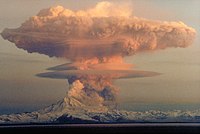
Photo from wikipedia
When a shock wave impacts a roughened metal/gas interface, metal ejecta particles emit and transport in the gas. The exchanges of momentum and energy between ejecta particles and the gas… Click to show full abstract
When a shock wave impacts a roughened metal/gas interface, metal ejecta particles emit and transport in the gas. The exchanges of momentum and energy between ejecta particles and the gas occur. If active metal particles transport in the reactive gas, the heat released by a chemical reaction could change these exchanges. In this paper, we use numerical simulations to study solid cerium ejecta transporting in a vacuum, and in non-reactive and reactive gases. In vacuum, the emitted ejecta could self-similarly expand neglecting the particle interaction. In the non-reactive gas (He), ejecta particles slow down by the gas resistance and have the exchanges of momentum and energy with the gas. In the reactive gas (D2), the ejecta particles also slow down. The exothermic reaction could induce the temperature rise of the ejecta and the gas, which could induce changes in physical property values of the gas after the shock wave and the velocity of the shock wave. The numerical result shows that the maximum temperature of the ejecta may appear in the middle of the mixture zone, which may result from the ejecta temperature being controlled by two competitive effects. Furthermore, the maximum ejecta temperature increases rapidly in the beginning and then becomes steady. Finally, the ejecta with a different initial size distribution is investigated. The ejecta with a smaller maximum size has a larger maximum particle temperature, a larger gas temperature after the shock wave, and a larger chemical reaction function of the ejecta at the same moment.
Journal Title: Journal of Applied Physics
Year Published: 2023
Link to full text (if available)
Share on Social Media: Sign Up to like & get
recommendations!